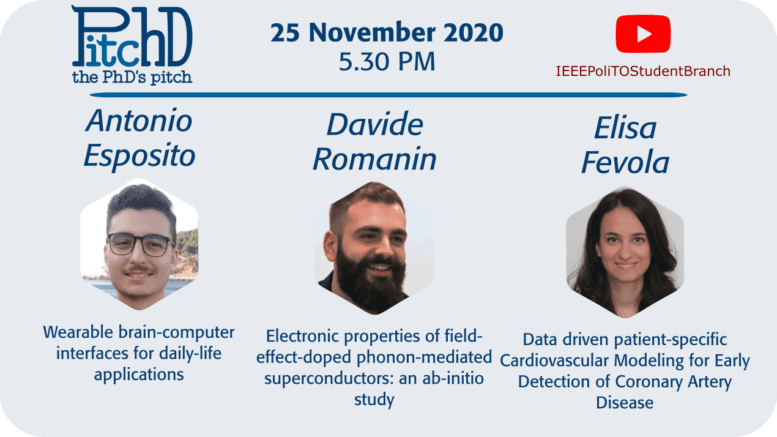25 November 2020 – 5.30 PM
ONLINE EVENT
YouTube Live Broadcast
Here’s the 8th PitchD – the PhD’s pitch. Our PhD IEEE Student Members explain to students, colleagues and professors their research.
Wearable brain-computer interfaces for daily-life applications
Mr. Antonio Esposito
Dept. of Electronics and Telecommunications (DET), Politecnico di Torino
Brain-computer interfaces (BCI) are communication channels alternative to natural peripheral nerves and muscles. Indeed, these were born for people with motor impairments, but they opened up new possibilities also in fields like gaming, entertainment, education, and industry. As in many other domains, what yesterday seemed just “magic”, today is becoming a technological reality. However, BCI applications outside the laboratory are still limited, and many research groups are trying to reach higher performances and user-friendliness. The present talk focuses on the development of non-invasive and wearable BCIs to be easily used in daily life. Two well-known paradigms are considered, namely “steady-state visually evoked potentials” and “motor imagery”, and the whole BCI loop will be briefly described, i.e. signal acquisition, signal processing, and possible applications. The overall aim of the R&D described in this talk is to contribute in spreading the BCI technology over the world.
Electronic properties of field-effect-doped phonon-mediated superconductors: an ab-initio study
Mr. Davide Romanin
Dept. of Applied Science and Technologyt (DISAT), Politecnico di Torino
The possibility of controlling transport properties of semiconductors by means of an external electric field goes back to the invention of the field-effect transistor (FET) in 1960 and in particular to its modern implementation, the metal-oxide-semiconductor field-effect transistor (MOSFET). However, field-effect doping can also be employed for modifying the conductivity of thin films of noble metals or tuning strongly correlated phases of matter (such as superconductivity, ferromagnetism, insulator-to-metal transitions, charge-density waves, etc.). In order to describe these situations and try to compare the experimental outcomes to theoretical predictions, it is important to understand how FET geometry affects the electronic properties of materials, e.g. using density functional theory (DFT). In this presentation I will show you how field-effect doping is treated in the framework of plane-waves pseudopotential DFT codes and what we can learn from the electronic band-structure using two case studies: niobium nitride (NbN) and hydrogenated diamond thin films.
Data driven patient-specific Cardiovascular Modeling for Early Detection of Coronary Artery Disease
Ms. Elisa Fevola
Dept. of Electronics and Telecommunications (DET), Politecnico di Torino
Coronary artery disease – the narrowing or blockage of coronary arteries – is one of the leading causes of mortality worldwide. The most common surgical treatment in this case is bypass grafting, where some arteries are used to bypass the blockage. Unfortunately, up to 60% of grafts fail some years after surgery, and the reasons behind such failures are still largely unknown. A huge help in this sense comes from engineers and mathematicians, which can use advanced computational models to simulate how blood flows in the affected arteries, sometimes borrowing modeling techniques from circuit applications. Such models provide information on a patient’s unique physiology, and may help clinicians in performing a better diagnosis and treatment planning. This talk will provide an overview of the use of computational models for cardiovascular applications and the ongoing work to overcome one of its main challenges, the correct choice of boundary conditions.


Be the first to comment on "PitchD 2020 edition: the 8th PitchD [ONLINE]"